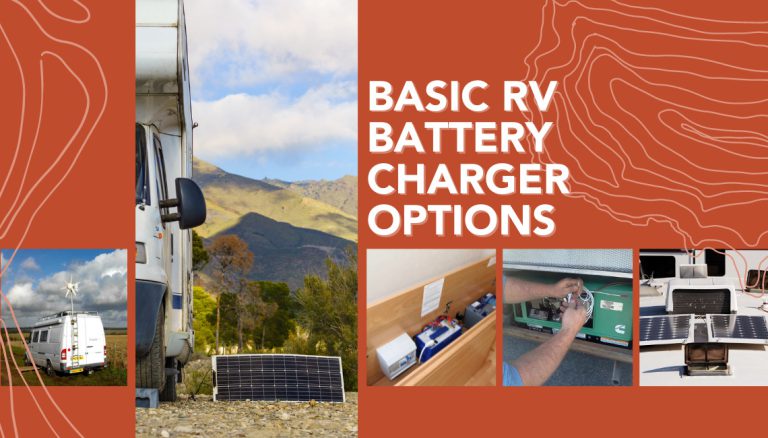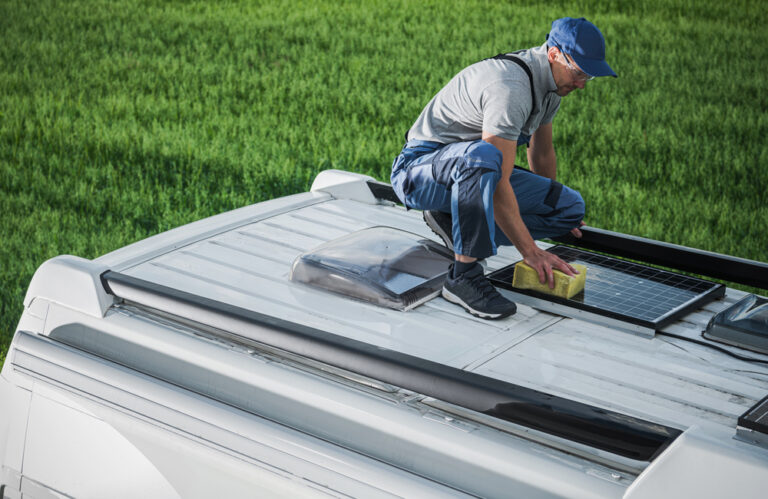
Most manufacturers add charging systems to RVs, but they are poorly made and will pose a threat to your RV battery. You don’t want it to over-charge due to this type of system. Therefore, it’s best to familiarize yourself with different chargers in order to prevent these accidents.
In this article, I will present you with various types of charges. When you learn more about them, you will know how to keep your battery charged up with the best RV Battery charger on the market.
8 important types of chargers out there, which are useful for the right RV. These are:
- Converter-charger
- Inverter-charger
- Single and Multi-Stage Chargers
- Solar Power
- Wind Power
- Generators
- Trickle Chargers
- “Echo” Chargers
1. Converter-Charger
This is one of the most basic RV charger/converter systems that converts 120v of shore power into 12V of DC power. Thanks to this your battery will store energy while you are plugged in. Besides this, it can charge your battery(s) when it has excess capacity.
The converter charger is rated in amps. About 55 amps of DC can power up the whole RV lighting and appliances and even do some charging as well. These types of chargers interact with the main power distribution panel and offer both a 12v and 12v function in one unit. It comes both in single and multi-stage products.
2. Inverter
This charger comes in a multi-stage format. If you have a Class A motorhome, then you definitely own an Inverter Charger. it’s basically the same as the converter charger but comes with something extra. It has the capability of producing 120 v AC from the battery 12v when you lack shore power. Well-known inverter charger brands are Magnum and Xantrex.
3. Single and Multi-Stage Chargers
Single Stage Charger
This type is found in a lot of motorhomes, especially in old ones. But how does it work?
For starters, we just can’t compare a battery to a sponge. They don’t just absorb amps and store them there indefinitely. A battery has to receive a higher voltage than its capacity in order to charge. Just think of it as a flat tire. As you try to inflate it you need to apply more air pressure in order to fill it up completely. If the pressure is weak, the tire will push it back out and it will totally deflate. So the battery starts to fill with amp-hours but pushes them back as they approach maximum capacity.
It’s called a “taper charge” when a fixed voltage is applied. You have a lot of amp flow at first but with constant charging of the battery, the rate decreases. This is the Single Stage method and it can be found in low and mid-range trailers and smaller motorhomes battery chargers.
Multi-Stage Charger
If you want to aim for a modern method then you should choose the multi-stage charger. This optimizes charging based on the three stages of the battery charge. These stages are Bulk, Absorption, and Float.
The Bulk is when you promptly charge the battery from a low charge to about 80% capacity. This will constantly charge the battery at 25% of amp capacity. Of course, this is when the battery pushes back so the charger kicks in and increases the voltage to keep the amps at a constant rate.
When it reaches a certain level, it switches to the Absorption Stage. This is all about maintaining a constant flow of voltage (about 14.1v – 14.8v) to the battery till it reaches maximum charge capacity or until Float mode switches on.
Float mode keeps the battery fully charged at 100% and maintains a voltage of 13.6. This also keeps the battery safe for a long period of time.
The multi-stage RV battery charger is better than the single-stage, but both work well when the battery is new and low on voltage. You can find a great multi-charger here.

4. Solar Battery Charger
A lot of people wish for innovative chargers that will supply power to their RVs almost indefinitely. RV Solar panels can be a great option in this situation.
Small solar panels have the ability to maintain battery power while it’s out of use. But they need to be 15 – 20 watts. Meanwhile, a large solar panel of 100 – 150 watts can offer more than enough energy to fully power your RV and supply energy for the entire day.
If you go for a 14+ voltage you will cover 1 amp needed to power the battery while it’s in standby mode. This is great since most RVs lose about 0.25 amps per hour without any outside solicitations. Some small solar panels are wired directly to the battery.
Although it sounds like a great option, solar panels take careful planning and a lot of components. You will need the help of a professional to help you with the installation. Make sure you inform yourself thoroughly if you want to opt for this type of charger.
5. Wind Chargers
If you are not a fan of solar energy, maybe wind chargers are right for you? You only need a propeller driving an alternator and the wind charger will provide energy.
Sadly, you likely can’t receive all the power you need through a wind turbine since they are usually small in size. However, if you camp in deserts or in mountain valleys where you can find an abundance of wind, then this wind charger can be a useful addition to your set-up.
6. Generators
Now, who needs chargers when you have your own personal generator? These can be bought from any store and produce enough energy to power an entire RV. They provide 120v of power and help the RV’s converter or inverter charger to recharge the battery.
You can find portable generators that have an output terminal that gives out DC current. That current can be used to power the battery directly, but it might not be enough to charge it completely. Also, it is a bit risky to power the battery directly from your generator. If you forget to turn it off when the charge is complete, you may encounter some shocking problems.
7. Trickle Chargers
The trickle charger is an RV Battery Charger or Maintainer that keeps the battery charged at 100%. It’s rather small and uses a single-stage unit. The best part is due to the advancement of technology the Trickle Charger has a Float Charge stage. The charger is set to hold a single 12v battery, but you may find multiple outputs in other models. Those models can handle 2 or more at the same time without any problems.
If you want to purchase this type of charger I suggest the Battery Minder or the Battery Tender.
8. “Echo” Chargers
Now, these are not exactly battery chargers. They are closer to a battery combiner that switches energy between batteries. This is a great option if your RV holds two types of batteries (preferably isolated from each other). The main charger is connected to the first battery while the combiner “echos” a portion of the charging amps to the second battery.
If you like to bring along a home battery this is an amazing way to charge the engine battery. This way you will have a backup battery for shore power and to charge the other when it starts to deploy. An amazing combiner is the Xantrex Echo Charger, if that doesn’t suit you, turn to the Ultra Trik-L-Start.
Conclusion
If you want to buy or upgrade your battery charger, you need to know what’s best for your RV. All types can work well and some can even work in conjunction with one another, but if you have to choose just one, we say go for a multi-stage charger.
You can learn more about algorithms and discharging here before you actually go shopping. Using this information and keeping in mind the places you are visiting or the number of days you will be away from home, you should be able to make the best decision for you.
This post contains affiliate links. RVshare may receive compensation if you make a purchase after clicking on a product or service link.
